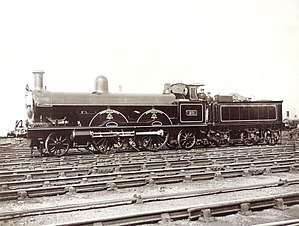LNWR John Hick Class
The London and North Western Railway (LNWR) John Hick class was a class of ten 2-2-2-2 steam locomotives designed for express passenger work by F. W. Webb.
| LNWR John Hick class | |||||||||||||||||||||||||||||||||||||||||||
|---|---|---|---|---|---|---|---|---|---|---|---|---|---|---|---|---|---|---|---|---|---|---|---|---|---|---|---|---|---|---|---|---|---|---|---|---|---|---|---|---|---|---|---|
 LNWR No. 20 John Hick | |||||||||||||||||||||||||||||||||||||||||||
| |||||||||||||||||||||||||||||||||||||||||||
| |||||||||||||||||||||||||||||||||||||||||||
| |||||||||||||||||||||||||||||||||||||||||||
History
They were broadly similar to the earlier Greater Britain class, the principal difference being smaller driving wheels, as their intended use was on the more-steeply graded Northern Section.
The first of the ten locomotives was built in February 1894, and the remaining nine came from Crewe Works between January and April 1898.
They were three-cylinder compound locomotives: the two outside high-pressure cylinders drove the trailing drivers via Howe-Stephenson valve gear, the one inside low-pressure cylinder drive the leading drivers via a slip eccentric. There was no connection between the two sets of drivers.
All the locomotives were named; one unusual feature (shared with the Greater Britain class) was that the names were split over two nameplates, one on each driving wheel splasher. This necessitated the use of two-word names, rather than some of the abbreviated names the LNWR had previously used. The names chosen continued the Greater Britain theme.
They continued in service until Webb's retirement. His successor, George Whale, preferred simple superheated locomotives; consequently they were all scrapped between 1907 and 1912.
Fleet list
| LNWR No. | Name | Crewe Works No. | Date built | Date scrapped | Notes |
|---|---|---|---|---|---|
| 20 | John Hick | 3505 | Feb 1894 | Apr 1910 | |
| 1505 | Richard Arkwright | 3858 | Jan 1898 | May 1912 | |
| 1512 | Henry Cort | 3859 | Feb 1898 | Oct 1907 | |
| 1534 | William Froude | 3860 | Feb 1898 | Dec 1909 | |
| 1535 | Henry Maudsley | 3861 | Feb 1898 | Aug 1910 | Name misspelt |
| 1536 | Hugh Myddleton | 3862 | Mar 1898 | Feb 1909 | |
| 1548 | John Penn | 3863 | Mar 1898 | Mar 1909 | |
| 1549 | John Rennie | 3864 | Mar 1898 | Aug 1909 | |
| 1557 | Thomas Savery | 3865 | Mar 1898 | Mar 1909 | |
| 1559 | William Siemens | 3866 | Apr 1898 | Oct 1910 |
References
- Baxter 1979, p. 196.
- Baxter, Bertram (1979). Baxter, David (ed.). British Locomotive Catalogue 1825–1923, Volume 2B: London and North Western Railway and its constituent companies. Ashbourne, Derbyshire: Moorland Publishing Company. ISBN 0-903485-84-2.
External Links
- LNWR Society Photographs of the Webb 2-2-2-2 John Hick class steam locomotives.
| Wikimedia Commons has media related to LNWR John Hick class. |